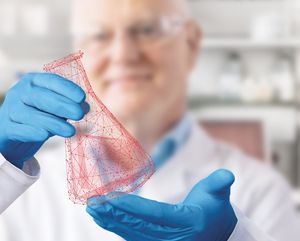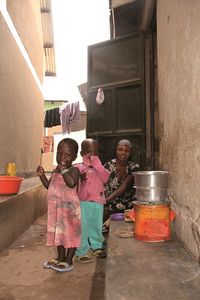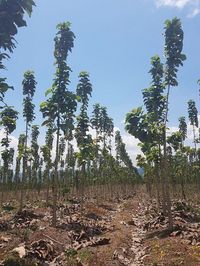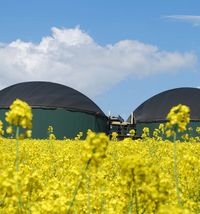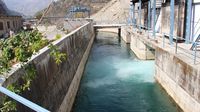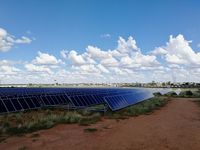Podpiramo svoje dobavitelje in nabavljamo trajnostno.
Naša proizvodnja: Odgovorna in CO2-nevtralna.
Kaj prispevajo naše stranke: Manj trenja, zmanjšana poraba energije.
Delimo rezultate naših raziskav ter podpiramo naše dobavitelje pri razvoju in uporabi trajnostnih in ogljično nevtralnih procesov.
Pri naših proizvodnih procesih se osredotočamo na varčevanje z viri in na prihranek energije.
Neizogibne emisije CO2 nadomestimo z izbranimi, certificiranimi projekti zaščite podnebja.
Uporaba naših izdelkov močno prispeva k pomoči okolju. Naše analize okoljske učinkovitosti kažejo: Zahvaljujoč dejavnikom, vključno z zmanjšanjem trenja, je znižanje CO2 izpustov bistveno večje kot pri konvencionalnih izdelkih.
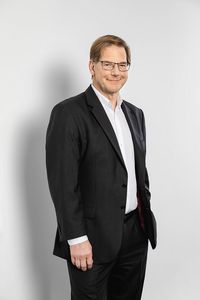
Pravi mejnik v zgodovini podjetja FUCHS: Od leta 2020 je FUCHS na vseh svojih več kot 60 lokacijah po vsem svetu popolnoma ogljično nevtralen - od porabe energije v proizvodnji pa vse do potrošnega materiala, uporabljenega v administrativnih postopkih. A vendar se ne osredotočamo samo na ekološki odtis v lastnih tovarnah, temveč se zanašamo na celoten proizvodni proces in vrednostno verigo naših izdelkov. Zato sodelujemo v raziskovalnih projektih trajnostne uporabe surovin. Skupaj z našimi dobavitelji razvijamo standarde in ukrepe za kvantificiranje in potrjevanje trajnosti vzdolž celotne vrednostne verige. Predvsem pa naši izdelki zmanjšujejo trenje in povečujejo energetsko učinkovitost našim kupcem - to ima tako finančni kot tudi ekološki vpliv.
Trajnostna nabava
Vemo, da samo ogljično nevtralni procesi znotraj našega podjetja niso dovolj. Naš cilj je torej dolgoročno prodajati ogljično nevtralne izdelke ter z nakupom surovin v to prepričati tudi naše dobavitelje. Navsezadnje so v primeru maziv, le-ti odgovorni za 90 odstotkov ogljičnega odtisa končnega izdelka. Nekatere naše dobavitelje že podpiramo pri iskanju ustreznih možnosti v okviru številnih raziskovalnih projektov. In za mizo smo pripeljali vse: dobavitelje, konkurente in kupce v našem evropskem industrijskem združenju UEIL. Cilj je doseči merljive ključne kazalnike uspešnosti in merila za trajnost.
Fokus na biogenih surovinah
Uporaba biogenih surovin iz Evrope kot obnovljivih, okolju prijaznih alternativ fosilnim surovinam je v središču številnih raziskovalnih pobud, pri katerih sodeluje FUCHS. Njihova glavna prednost je, da ne povečajo ravnotežja ogljika in njihova uporaba pogosto pomeni nov vir dohodka za domače kmetijstvo.
Aktivni igralec na področju trajnosti
FUCHS strategija ogljične nevtralnosti je vključena v našo trajnostno strategijo, ki se je začela leta 2010, ko smo podpisali "Kodeks odgovornega poslovanja". Leta 2018 smo se pridružili "Zavezništvu za razvoj in podnebje", ki ga vodi Zvezno ministrstvo za gospodarsko sodelovanje in razvoj. Hkrati smo ustanovili trajnostno delovno skupino pod okriljem Unije evropske industrije maziv (UEIL). Skupaj razvijamo usklajene trajnostne standarde, ključne kazalnike uspešnosti in merila uspešnosti, ki omogočajo primerjave na osnovi trajnosti.
Trajnostna proizvodnja
Seveda je prva stvar, ki jo pogledamo v smislu trajnosti na vseh naših lokacijah po vsem svetu, lastna proizvodnja, saj lahko tu naredimo neposredne spremembe. Na ta način smo od leta 2010 uspeli znižati emisije CO2 na proizvedeno tono maziva za 30 odstotkov. Z nenehno optimizacijo postopkov in procesov bomo še zmanjšali porabo energije in vode ter še povečali delež obnovljivih virov energije, ki trenutno znaša 27 odstotkov. Na ta način bomo lahko srednjeročno podpirali ukrepe za odškodnino za ogljik s podporo podnebnim projektom.
Primer dobre prakse v Veliki Britaniji
Britanska podružnica FUCHS daje dober zgled. Okoli 2000 sončnih kolektorjev na strehi nove pisarne na sedežu podjetja v Hanleyju, Stoke-on-Trent, proizvede približno 14 odstotkov energije, potrebne za celotno lokacijo. 95 odstotkov razsvetljave zagotavljajo LED luči - v novem, popolnoma avtomatiziranem skladišču s 4.000 paletnimi prostori, ki je trenutno v gradnji, pa načrtujejo sistem za zbiranje deževnice.
Proizvodni obrat ogreva testni laboratorij
Odličen primer ekološke odgovornosti na lokaciji v Mannheimu: Visokotemperaturni kondenzat iz sosednjega proizvodnega obrata se uporablja za ogrevanje novo zgrajene zgradbe testnega laboratorija ter sosednjega skladišča. Visokotemperaturni kondenzat prek izmenjevalnikov toplote oskrbuje tako prezračevalne sisteme kot tudi grelnike in strope stavbe testnega laboratorija. Okolju prijazen rezultat: vsako leto prihranimo 18 ton ogljikovega dioksida.
Podpora projektom varstva podnebja
Trenutno se vsem emisijam ni mogoče popolnoma izogniti - preostale emisije nadomestimo z vključevanjem v izbrane projekte varovanja podnebja v regijah, kjer imamo lastne obrate. Naš poudarek je na širitvi obnovljivih virov energije. Projekti morajo imeti mednarodno priznano potrdilo, kot je Zlati Standard. Njegova merila razvijajo organizacije, kot je WWF.
Štedilniki za Peru in Ugando
V nasprotju s podeželskimi predeli Peruja in tudi Ugande, pri pripravi hrane redko uporabljamo odprti ogenj. S kuhanjem na odprtem ognju je povezanih veliko negativnih učinkov. Strupene pare otežujejo dihanje v bivalnih prostorih, potreba po velikih količinah drv pa vodi v sečnjo gozdov in visoke stroške za gospodinjstva. S pobudo "Qori Q'oncha" v Peruju so od leta 2008 razdelili skoraj 80.000 inovativnih štedilnikov, kar omogoča zmanjšanje 75.526 ton CO2 na leto. Podoben projekt "Učinkoviti štedilniki v Ugandi" je od leta 2006 opremil že več kot 500.000 gospodinjstev z učinkovitimi pečmi, kar je prispevalo k zmanjšanju emisij za približno 450.000 ton CO2 v tej afriški državi.
Pogozdovanje v Mehiki
Zemljišča v mehiških zveznih državah Tabasco, Chiapas in Campeche se uporabljajo predvsem za živinorejo in kmetijstvo. Projekt "Pogozdovanje s tikovino - CO2e TEAKIMEX" že od leta 2013 pošilja močno sporočilo o varovanju podnebja s sajenjem tikovine. Za izboljšanje biotske raznovrstnosti v teh regijah se ponovno zasadi približno 4000 hektarjev zemlje. Na tem gozdnem območju bo v 36 letih shranjenih približno 37.000 ton emisij toplogrednih plinov. Poudarek je tudi na ustvarjanju trajnostnih delovnih mest.
Ogrevanje iz bioplina na Kitajskem
Kmetje iz okrožja Hezhang v gorski provinci Guizhou na jugozahodu Kitajske imajo v povprečju po 4,5 prašiča. Projekt "Hezhang Rural Methane Digesters Project" se osredotoča na živali, ki jih redijo te manjšine, saj podpira kmete pri gradnji metanskih digestorjev z zmogljivostjo 8 kubičnih metrov. Ti se lahko uporabljajo za pridobivanje bioplina iz prašičjega gnoja in drugih odpadkov. Z dvotirnim pristopom se vsako leto prihrani približno 50 099 ton emisij. Prvič, zaradi pridobivanja toplote za ogrevanje in kuhanje tako ni potrebe po fosilnih gorivih. Drugič, emisije CH4 se zmanjšajo zaradi pridobivanja energije iz odpadkov.
Hidroelektrarna na reki v Indiji
Za okrožje Chamoli na severu Indije sta značilni šibka infrastruktura in mrzle zime. Ni stalne oskrbe z električno energijo - čeprav se bo to sedaj spremenilo z gradnjo hidroelektrarne, ki bo v regionalno električno omrežje dovajala približno 40 GWh čiste energije. Projekt hidroelektrarne bo prihranil tudi približno 37 278 ton emisij toplogrednih plinov, saj prebivalci po vzpostavitvi okolju prijazne oskrbe z električno energijo ne bodo več potrebovali klasičnega ogrevanja z lesom. To bo pripomoglo tudi k preprečevanju degradacije gozdov, erozije tal in zmanjšane rodovitnosti tal.
Sončne elektrarne za Namibijo
Namibija je odvisna od sosednje Južnoafriške republike, ki ji zagotavlja približno 60 odstotkov električne energije, za kar večinoma uvaža gorivo iz tamkajšnjih premogovnikov. V sami Namibiji električno energijo proizvajajo predvsem hidroelektrarne, čeprav so te podvržene številnim prekinitvam delovanja in izpadom. Zanesljivost oskrbe se lahko zdaj trajnostno izboljša zaradi gradnje in delovanja dveh novih sončnih elektrarn v bližini mesta Gobabis na vzhodu Namibije. Ti novi elektrarni naj bi letno zagotovili 28 GWh čiste sončne energije - in tudi zmanjšali emisije CO2 v jugozahodni Afriki za 27.000 ton na leto.
Trajnostna uporaba
Skupna študija družbe FUCHS in kemičnega podjetja BASF je jasno pokazala, da je faza uporabe ključna za ekološko učinkovitost v celotnem življenjskem ciklu naših izdelkov. Tu maziva FUCHS z zmanjšanjem trenja, obrabe in korozije pomagajo omejiti porabo energije in s tem izboljšati ogljični odtis naših strank. V številnih raziskovalnih projektih si s pomočjo naših maziv prizadevamo za nadaljnje izboljšanje energetske učinkovitosti in učinkovitosti virov pri pogonih.
Partnerji na področju trajnosti
Družbi FUCHS in BASF sta že leta 2015 začeli intenziven dialog na temo trajnosti. Zadnji rezultat tega tesnega sodelovanja je analiza ekološke učinkovitosti v celotnem življenjskem ciklu treh različnih hidravličnih olj FUCHS. Sklepna ugotovitev: faza uporabe je ključna za okoljsko učinkovitost testiranih hidravličnih olj.
Raziskave za stranke
Vodne tekočine, ki omogočajo bistveno manjše trenje v različnih aplikacijah. Maziva, ki so odporna na posebej obremenjena območja ventilovega razvoda v plinskih motorjih. Razvoj olja za e-motorje za električna vozila, ki ne maže le menjalnika, temveč tudi hladi e-stroj in napajalno elektroniko. Podjetje FUCHS vnaša svoje strokovno znanje v številne raziskovalne pobude z enim samim ciljem: povečati učinkovitost in trajnost proizvodnje svojih strank.
FUCHS to be CO2-neutral globally by 2020
Climate change is one of the greatest challenges of our time and it affects the whole human race, even though we in Central Europe are lucky enough to feel the effects only to a comparatively small extent. In other regions of the world, the consequences of global warming such as rising sea levels and the drying-up of lakes and rivers are existential threats for the people living there. The rich industrialized nations emit a comparatively large amount of CO2, especially through intensive industrial production. So for FUCHS, our commitment to global climate protection means assuming global responsibility with regard to economic, ecological and social aspects. In October 2019, therefore, FUCHS joined the “Alliance for Development and Climate” of the German Federal Ministry for Economic Cooperation and Development (BMZ) as an official supporter. The members of this alliance, which combines climate protection and sustainable development, strive for CO2-neutrality by avoiding, reducing and offsetting CO2 emissions at the same time.
Climate-damaging CO2 emissions result from numerous processes directly or indirectly related to the combustion of fossil fuels. Since CO2 emissions impact on the climate at a global level, it is ultimately irrelevant where on the planet they originate and where they are saved. So the offsetting of emissions proportionate to the amount produced – for example, through investments in international climate protection projects – ultimately ensures that the carbon footprint remains neutral. With carbon offsetting, therefore, the added value for the environment is generated through the voluntary promotion of climate protection projects, which would not be possible without such additional income. This voluntary financial support not only helps the selected countries to improve their economic, social and ecological circumstances, but is also a major driver for the transfer of clean technologies and sustainable global economic development.
Although the direct CO2 footprint in the manufacture of lubricants is comparatively low – a factor that sets FUCHS apart from the rest of the chemical industry – it was and remains our aim to reduce it continuously and systematically. For example, energy-consumption-specific CO2 emissions per ton of FUCHS lubricant produced have already been reduced by a total of around 30% since 2010. Global CO2-neutrality is another milestone in our FUCHS sustainability strategy, which we launched ten years ago. Sustainability is one FUCHS’ core corporate values. The success of global emission reductions depends to a great extent on the voluntary and systematic actions of the business sector in industrialized countries. This is why we decided to take our share of responsibility and offset our CO2footprint. In this way, we are taking responsibility for global climate protection and making an important contribution to achieving the goals of the UN climate protection agreement ratified in Paris in 2015. This agreement aims to limit global warming to well below two degrees Celsius compared with pre-industrial levels. We want to actively protect our environment and help our customers to do their bit, too. From January 1, 2020, our customers across the world will receive lubricants from FUCHS as a CO2-neutral lubricant company, produced in CO2-neutral processes.
From 2020, FUCHS will be completely CO2-neutral globally.This means that it will no longer leave a CO2 footprint and thus no longer have a negative impact on CO2 concentrations in the atmosphere. As an industrial company, FUCHS will continue to emit CO2. This is unavoidable in many places. But from 2020, we will neutralize all our CO₂ emissions from our 58 FUCHS locations worldwide – from energy consumption in production to consumables in administration. To achieve CO2-neutrality as early as 2020, FUCHS will offset its previously unavoidable CO2 emissions with compensation measures. This will be done by investing in high-quality climate protection projects aimed primarily at promoting renewable energies.
The step towards global FUCHS CO2 neutrality from January 1, 2020 was prepared for one year and accompanied by the sustainability consultancy Fokus Zukunft. Fokus Zukunft reviewed the calculation of FUCHS’ CO2 emissions in September 2019 and confirmed the accuracy of the data basis and the application of the Greenhouse Gas Protocol guidelines as the calculation standard for determining CO2 emissions. Fokus Zukunft then certified the FUCHS Group as a CO2-neutral company, which means that FUCHS will be entitled to declare itself CO2-neutral from January 1, 2020.
Neutrality refers to the global CO2footprint generated by FUCHS at all its worldwide locations through heat, fuel and electricity consumption in production, administration and research processes, through upstream energy-related emissions, business trips, hotel overnight stays and employee commutes as well as through waste generation and waste water in the company. This enables us to precisely calculate the CO2 emissions generated. Based on this calculation, FUCHS then makes compensatory investments in climate protection projects to offset the corresponding amount of CO2.
Our projects are accredited, approved and monitored according to internationally recognized certification standards such as the Gold Standard as well as by renowned organizations such as the United Nations (UN). The projects certified according to the Gold Standard fulfill especially stringent requirements. They not only save CO2, but also contribute to local sustainable development. The validation of the project results with regard to the CO2 savings achieved is verified by independent testing bodies such as TÜV.
When selecting projects, we focus on high-quality voluntary climate protection projects that support economic, ecological and social development worldwide in countries and regions of the “Global South” with FUCHS locations and where these projects are aimed primarily at promoting renewable energies. According to the current list of the German Federal Ministry for Economic Cooperation and Development (BMZ), the “Global South” refers to socially, politically and/or economically disadvantaged countries. In this way, FUCHS fulfills its global social responsibility in the sense of corporate citizenship. At the same time, we are also supporting most of the 17 sustainable development goals of the UN, to which we have officially committed ourselves since 2018. When selecting projects, we also ensure that we support at least one high-quality project every year within each of the six project sectors (biomass, ovens, solar energy, forest conservation, hydropower, wind energy).
CO2 offsetting means that greenhouse gases that are produced in one region of the earth and cannot be avoided are compensated by climate protection projects in another region. To finance these, companies buy certificates for a range of different projects. Each certificate represents 1 ton of CO2 saved by the project. Numerous climate protection projects – most of them in the field of renewable energy – have been launched worldwide. In return for their participation, the project initiators receive emission credits, which can be traded in the form of climate protection certificates. The amount is calculated, for example, on the basis of a comparison with the emissions that would have resulted from the construction of a coal-fired power plant.
Yes, because they are tested and certified by independent institutions – a minimum requirement for FUCHS. These institutions – including various TÜV companies – issue the certificates according to internationally applicable standards. A key aspect of emissions trading is the retirement of certificates after they have been acquired. Retirement must be clearly documented. Each CO2 offset ends with the documented retirement of the certificates. This ensures that the same certificates are not traded more than once, which, in turn, would invalidate the principle of balance. FUCHS acquired its climate protection project certificates via Fokus Zukunft and the organisation First Climate.
Voluntary CO2offsetting works according to the principle that greenhouse gas emitters invest in and support voluntary climate protection projects by purchasing emission reduction certificates. Prices depend on the individual project; in other words, when an emission reduction certificate is purchased, a third party is commissioned to save one ton of CO2 in the atmosphere in another region of the earth on the company’s behalf. Pricing on the CO2 market is also determined by supply and demand. Projects that, above and beyond simple climate protection, offer additional benefits for the people and the environment in the region where the project is being undertaken frequently achieve higher prices on the market.
With CO2 offsetting, the added value for the environment is generated through the voluntary promotion of climate protection projects, which would not be possible without the additional income. Only climate protection projects that can prove their added value within the framework of certification are recognized and so gain access to the market. Trading in CO2 reduction certificates follows a principle known as “results-based finance.” This refers to the idea that the developers of climate protection projects can issue emission reduction certificates only if their project has already been implemented and demonstrably helps to reduce CO2 emissions. So anyone who acquires CO2 reduction certificates in order to compensate for their own emissions can be confident that purchasing certificates will be matched by a real benefit for climate protection. This mechanism, which is embedded in the Kyoto Protocol, has become firmly established over the past 20 years and proven itself as a central component of voluntary, non-governmental climate protection. The process is supported by the UN, numerous non-governmental organizations and hundreds of large companies, including those in the petroleum industry. FUCHS invests exclusively in projects that meet the above criteria and was able to choose its project partner and climate project with the support of Fokus Zukunft respectively First Climate. But it is also clear that this form of CO2 offsetting will merely support and not replace our ongoing efforts to globally reduce our (avoidable) CO2 emissions.
FUCHS continues to follow the principle of avoid–reduce–offset. Around 80% of FUCHS’ CO2 emissions are caused by heat and electricity consumption, so energy efficiency is an important lever in avoiding or reducing CO2. In the medium term, FUCHS intends to gradually reduce its CO2 compensation payments and increase its share of renewable energy supplies while continuing to invest in improving the energy efficiency of its locations.
In the long term, the company aims to sell CO2-neutral products to its customers. However, this also requires that FUCHS will in the future receive CO2-neutral raw materials from its suppliers – after all, these account for around 90% of the carbon footprint of FUCHS lubricants. As the world’s largest independent manufacturer, however, we occupy a central position in the lubricant market and so are well-positioned to exert our influence in the upstream value chain. We expect our suppliers in the future to use more sustainable, innovative preliminary products so that they can supply us with either lower-carbon or CO2-neutral raw materials for lubricant production. Only in this way can FUCHS, as a CO2-neutral lubricant company, offer its customers CO2-neutral lubricants from CO2-neutral production.
Absolutely. Through a number of internal and external measures, FUCHS not only promotes its own CO2-neutrality and, in turn, climate protection as a whole, but it has also been developing, producing and marketing numerous emission-reducing and eco-friendly lubricants for almost 90 years. So during the application phase, these products make a greater contribution to saving energy and CO2 emissions than conventional alternatives thanks to reduced friction and their ability to protect against wear and corrosion. FUCHS has begun to quantify these higher CO2 savings effects by performing lifecycle analyses and assessments so that, in the future, it can categorize its lubricant portfolio by the CO2 footprint of individual product groups. We believe that the CO2 categorization of the product portfolio will become a key component in the production specifications published by lubricant manufacturers and, in addition to performance and price, a key differentiating feature and, in turn, a competitive advantage for FUCHS. One objective of our business activities is to develop solutions aimed at reducing the CO2 footprint of not only our raw materials and lubricant production processes, but also of our customers.
